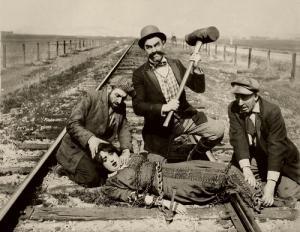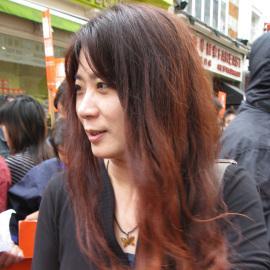This essay first appeared on Cliterati on April 21st; I have modified it slightly for time references and to fit the format of this blog.
 Most people yearn for a simple world where the goodies wear white hats and the baddies black, where people and behaviors can be easily sorted into neat little boxes, where good intentions lead to good outcomes and bad intentions lead to harm, and where everyone agrees on hierarchies of morality and the relative importance of different principles such as profit, honesty, self-respect, adherence to external mores, etc. But the real world isn’t like that at all: morality and motivations are often ambiguous, different individuals assign different weights to various principles, noble intentions can lead to disaster and base to commonweal, and the few people who wear “hats” at all favor a multiplicity of shades.
Most people yearn for a simple world where the goodies wear white hats and the baddies black, where people and behaviors can be easily sorted into neat little boxes, where good intentions lead to good outcomes and bad intentions lead to harm, and where everyone agrees on hierarchies of morality and the relative importance of different principles such as profit, honesty, self-respect, adherence to external mores, etc. But the real world isn’t like that at all: morality and motivations are often ambiguous, different individuals assign different weights to various principles, noble intentions can lead to disaster and base to commonweal, and the few people who wear “hats” at all favor a multiplicity of shades.
An article by Hsiao-Hung Pai in the Guardian illustrates this complicated reality in several different ways, the first being the venue itself; though the Guardian is happy to provide a platform for prudes and prohibitionists, it is equally amenable to publishing pro-sex worker articles and carried one of the earliest debunkings of “sex trafficking” hysteria three and a half years ago. This has nothing to do with any lofty journalistic ethos; the primary motivation of a newspaper is to make a profit, and from the perspective of the editorial board any good or ill to sex workers which occurs as a by-product of that process is purely incidental. The motive of the reporter herself (to write and sell a book) was similar to that of the paper, but her behavior went beyond the merely amoral to the reprehensible; in furtherance of her goal she lied, misrepresented herself, spied on sex workers, recorded their conversations without their consent and used their stories to generate profit for herself, and it is entirely possible that her actions may result in brothel raids and other dire consequences for her unwilling sources.
Though the book was researched unethically, if this excerpt is a fair indication it depicts migrant women as free agents motivated by the desire to provide for their families:
Ah Fen…had been in Britain for four years. During the first two years, like many newly arrived Chinese, she worked in catering. In the third year she was laid off amid increasing raids on Chinese restaurants by the immigration authorities. A friend introduced her to the sex trade. With no skills to find other work, she accepted immediately. She told me it was the best decision she had made during her time in Britain: her income had gone through the roof and the money she had been able to send home was making a real difference to her family. ”In a good week, I can earn £1,500 to £2,000,” she told me…Another [named]…Ah Ling…[said] “I wasted my first three years in England working in restaurants and takeaways doing tough work with little reward…A year ago, a friend of mine in the sex trade suggested I try doing this. She said: ‘Try it once and see if you are OK with it.’ Frankly, I had no real alternatives…Now I regret not having started it as soon as I got here.” Sex work had transformed Ah Ling’s life. She had paid off all her debts within a year and was earning £600 a week. Her current aim was to pay for a new house back home for her family, and return after two more years of sex work…
 On the other hand, those heavily invested in “trafficking” myth see this through a distorted filter; one reviewer on Amazon called her reckless disregard for the welfare of migrant sex workers “compassionate” and claimed, “Hsiao-Hung Pai…videotaped the underworld of pimps and madams who make their living off slaving women in need…[and] deflates the myth of sex work as a free choice for migrant women.” This “true believer” denies the testimony of the workers, refers to a £2,000/week job as “slavery” and otherwise warps the narrative to her own ends; similarly, some of the post-article commenters insist on imposing Christian concepts of female sexual purity onto Asian women who do not share it, derailing nuanced discussions of pragmatism with lurid appeals to emotion. Yet at the same time, anyone who reads the text without the filter of “trafficking” dogma can see that it actually demonstrates the falsity of that paradigm, and adds more evidence to the growing heap which will eventually demolish it; many examples of such readers also appear in the comments. In the end, will the net effect of Hsiao-Hung’s self-serving, callous “investigation” be positive or negative? Will it ever be possible to tell?
On the other hand, those heavily invested in “trafficking” myth see this through a distorted filter; one reviewer on Amazon called her reckless disregard for the welfare of migrant sex workers “compassionate” and claimed, “Hsiao-Hung Pai…videotaped the underworld of pimps and madams who make their living off slaving women in need…[and] deflates the myth of sex work as a free choice for migrant women.” This “true believer” denies the testimony of the workers, refers to a £2,000/week job as “slavery” and otherwise warps the narrative to her own ends; similarly, some of the post-article commenters insist on imposing Christian concepts of female sexual purity onto Asian women who do not share it, derailing nuanced discussions of pragmatism with lurid appeals to emotion. Yet at the same time, anyone who reads the text without the filter of “trafficking” dogma can see that it actually demonstrates the falsity of that paradigm, and adds more evidence to the growing heap which will eventually demolish it; many examples of such readers also appear in the comments. In the end, will the net effect of Hsiao-Hung’s self-serving, callous “investigation” be positive or negative? Will it ever be possible to tell?
For the final layer of complexity, we must look to the text itself. The brothel madam described therein (“Grace”) is a thoroughly nasty person, as self-centered, mercenary and unconcerned with others’ welfare as the newspaper and the journalist. But compare her actions with Hsiao-Hung’s; though the latter’s profession is “respectable” and the prohibitionists laud her work as “good” while painting the former’s as despicable, their own actions demonstrate otherwise. Though Grace was rude and abusive, her coercion was strictly verbal and situational; women were free to walk away and find other work (even sex work with a different madam) if they chose. The journalist, however, denied her subjects the information they needed to “opt out” of participating in her commercial enterprise; they were recorded without their knowledge or consent. Furthermore, the sex workers profited handsomely from putting up with Grace’s abuse, whereas their only reward from being “pimped” by Hsiao-Hung is having their lives offered up for scrutiny by judgmental prudes and their persons potentially targeted for harassment, detention and deportation. Who is the true “exploiter” here? Who are the “goodies” and who the “baddies”? In a world without scripts, stereotypes and endings neatly resolved just in time for the closing credits, these questions are a lot more complicated than in the two-dimensional, black-and-white world imagined by naïve moralists.
